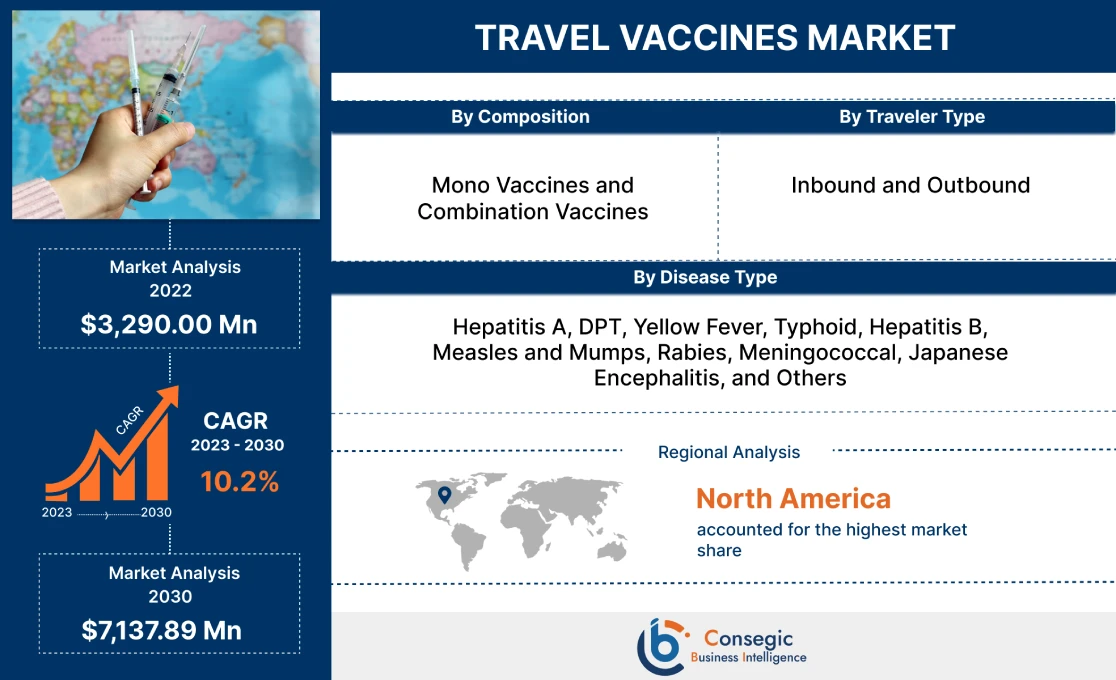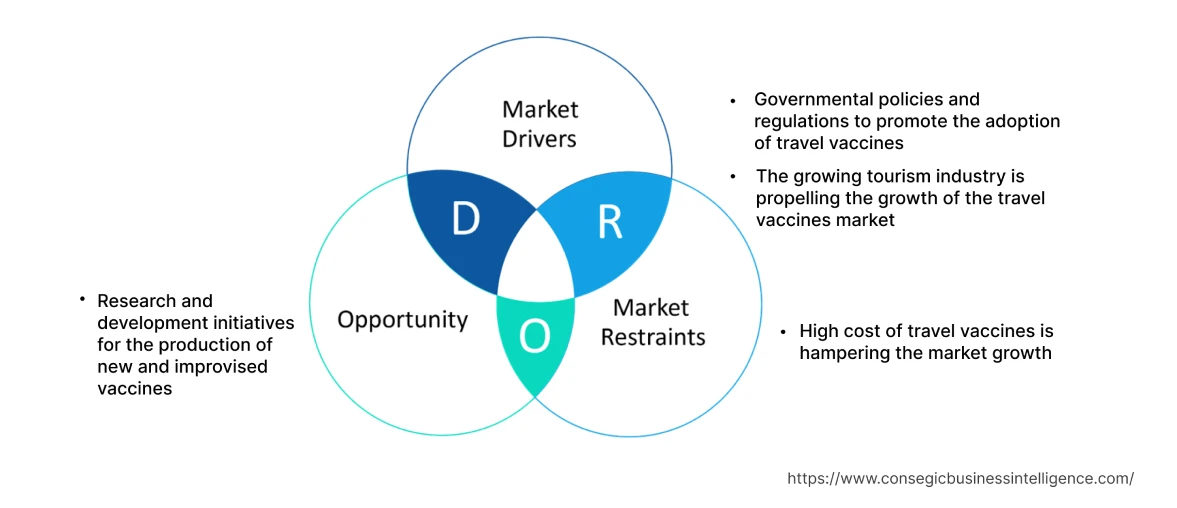Travel Vaccines Market Size :
Consegic Business Intelligence analyzes that the Travel Vaccines Market size is growing with a healthy CAGR of 10.2% during the forecast period (2023-2030), and the market is projected to be valued at USD 7,137.89 million by 2030 from USD 3,290.00 million in 2022.
Travel Vaccines Market Scope & Overview:
Travel vaccines are specifically designed to protect individuals from diseases that pose a higher risk of exposure in specific travel destinations. Such types of vaccines provide travelers immunity against diseases that they are likely to encounter during traveling. The vaccines help to reduce the chances of infection and related complications. As per the analysis, the commonly administered vaccines for traveling are commercialized in the market as yellow fever vaccine, typhoid vaccine, and Hepatitis A Vaccine, Hepatitis B Vaccine, among others. These different types of vaccines for traveling have different functions such as,
Yellow fever vaccine- Yellow fever is a viral disease transmitted by mosquitoes in certain regions of Africa and South America. The yellow fever vaccine provides long-term protection and is required for entry into these countries.
Hepatitis A Vaccine- Hepatitis A is a viral infection affecting the liver and is transmitted through contaminated food and water. The hepatitis A vaccine provides immunity against this disease, which is prevalent in many parts of the world.
Hepatitis B Vaccine: Hepatitis B is a viral infection transmitted through contact with infected blood, bodily fluids, or contaminated needles. The hepatitis B vaccine is recommended for travelers engaging in activities such as exposure to blood or sexual contact.
Travel Vaccines Market Insights :
Travel Vaccines Market Dynamics - (DRO) :
Key Drivers :
Governmental policies and regulations to promote the adoption of travel vaccines
Many countries have specific regulations and travel requirements related to vaccinations. Some of the regions also require proof of certain vaccinations for entry. Hence, as per the analysis, to meet the necessary immunization requirements, the travel vaccines market demand is increasing.
For instance, the World Health Organization recommends that travelers must receive the yellow fever vaccine to travel to certain countries in Africa and South America. Further, the World Health Organization also recommends that travelers must obtain a valid International Certificate of Vaccination or Prophylaxis (ICVP) as proof of vaccination required for entry into certain countries. Hence, such types of governmental regulations and policies are promoting the administration of these vaccines.
The growing tourism industry is propelling the the travel vaccines market growth
The increasing trends of the tourism industry is due to rising international business activities and the exploration of different destinations. Further, the increasing rate of people traveling to different regions and countries is also boosting the demand of the market. The growing tourism industry is a greater need for protection against diseases prevalent in those specific areas. As a result, based on the analysis, travelers are advised to seek appropriate vaccinations to protect themselves from diseases specific to their travel destinations.
For instance, according to the World Tourism Organization, France recorded the highest volume of inbound travelers worldwide reaching 48.4 million people in 2021. Hence, the growing number of international travelers and the growing tourism industry is contributing to the increased demand for these vaccines.
Key Restraints :
High cost of travel vaccines is hampering the market growth
The cost of these vaccines is relatively high, particularly during the administration of multiple doses or booster shots. Further, the addition of consultation fees and administration charges increases the overall cost of travel vaccines.
Moreover, as per the analysis, travelers visiting multiple destinations require vaccinations for different diseases that are prevalent in each location. Hence, this cumulative cost of multiple vaccines imposes a significant financial burden, particularly for long-term travelers or those exploring various regions. Thus, the high cost is likely to hamper the travel vaccines market trend.
Future Opportunities :
Research and development initiatives for the production of new and improvised vaccines
The increasing engagement of key players in research and development activities for the production of new and improvised vaccines. The development of such types of vaccines that can target the emerging diseases prevalent in specific travel destinations is providing a lucrative travel vaccines market opportunities and trends over the forecast period.
Further, as per the analysis, market players are investing in R&D activities to expand their product portfolios, offering novel and improved vaccines that address evolving health risks and cater to the diverse needs of travelers.
For instance, in February 2023, Bavarian Nordic completed the acquisition of a travel vaccine portfolio from Emergent Biosolutions. Bavarian Nordic has acquired two market vaccines, Vivotif for the prevention of typhoid fever and Vaxchora for the prevention of cholera.
The acquisition also includes U.S.-based research and development facilities and a Swiss-based biologics manufacturing facility. This addition of facilities across both U.S. and Europe is likely to strengthen the manufacturing capabilities of the companies to develop and deliver more life-saving vaccines around the world, thereby increasing the market opportunities and trends over the forecast period.
Travel Vaccines Market Report Insights :
| Report Attributes | Report Details |
| Study Timeline | 2017-2030 |
| Market Size in 2030 | USD 7,137.89 Million |
| CAGR (2023-2030) | 10.2% |
| By Composition | Mono Vaccines and Combination Vaccines |
| By Disease Type | Hepatitis A, DPT, Yellow Fever, Typhoid, Hepatitis B, Measles and Mumps, Rabies, Meningococcal, Japanese Encephalitis, and Others |
| By Traveler Type | Inbound and Outbound |
| By Geography | North America, Europe, Asia Pacific, Latin America, and Middle East & Africa |
| Key Players | GSK plc., Sanofi, Merck & Co., Inc., Pfizer Inc., Bavarian Nordic, Emergent, Seqirus, Valneva SE, Abbott, and AstraZeneca |
| Geographies Covered | |
| North America | U.S. Canada Mexico |
| Europe | U.K. Germany France Spain Italy Russia Benelux Rest of Europe |
| APAC | China South Korea Japan India Australia ASEAN Rest of Asia-Pacific |
| Middle East and Africa | GCC Turkey South Africa Rest of MEA |
| LATAM | Brazil Argentina Chile Rest of LATAM |
| Report Coverage | Revenue Forecast, Competitive Landscape, Growth Factors, Restraint or Challenges, Opportunities, Environment & Regulatory Landscape, PESTLE Analysis, PORTER Analysis, Key Technology Landscape, Value Chain Analysis, Cost Analysis, and Regional Trends & Forecast |
Travel Vaccines Market Segmental Analysis :
By Composition :
The type segment is categorized into mono vaccines and combination vaccines. In 2022, the mono vaccines segment accounted for the highest share in the travel vaccines market. Mono vaccines are single vaccines that protect against specific diseases such as Hepatitis A, Hepatitis B, Typhoid, Yellow Fever, Rabies, and others. Further, mono vaccines are generally more accessible and widely available compared to combination vaccines. Such types of vaccines are produced and distributed by pharmaceutical companies, healthcare facilities, and government immunization programs.
However, as per the analysis, combination vaccines are expected to be the fastest-growing segment in the travel vaccines market during the forecast period. Combination vaccines offer protection against multiple diseases in a single vaccine formulation. Such types of vaccines reduce the number of injections needed, making the vaccination process more convenient for travelers.
Further, combination vaccines are cost-effective as compared to multiple individual vaccines which is a key factor anticipated to drive the segment growth and trends over the forecast period.
By Disease Type :
The disease type segment is classified into hepatitis A, DPT, yellow fever, typhoid, hepatitis B, measles and mumps, rabies, meningococcal, Japanese encephalitis, and others. In 2022, the hepatitis A segment accounted for the highest travel vaccines market share of 20.11% in the travel vaccines market. Hepatitis A is a highly prevalent disease in many regions of the world and is a highly contagious liver infection caused by the hepatitis A virus. Hepatitis A is primarily transmitted through contaminated food and water.
Further, as per the analysis, the increasing number of travelers consuming local food and beverages or coming into contact with inadequate sanitation and hygiene conditions are suffering from hepatitis A which is driving the demand for the hepatitis A vaccine. Hence, the rising cases of hepatitis A are boosting the revenue growth of the travel vaccines market.
However, the typhoid segment is expected to grow at the fastest CAGR over the forecast period. Typhoid is a life-threatening infection caused by the bacterium Salmonella Typhi. Typhoid is common in places with poor sanitation and a lack of safe drinking water. Further, the administration of typhoid vaccines along with access to safe water and adequate sanitation helps in preventing typhoid fever.
For instance, according to the Centers for Disease Control and Prevention, approximately 21 million cases of typhoid fever and 200,000 deaths occur worldwide each year. Hence, the rising cases of typhoid fever are driving the need for effective typhoid vaccination, in turn, boosting the travel vaccines market.
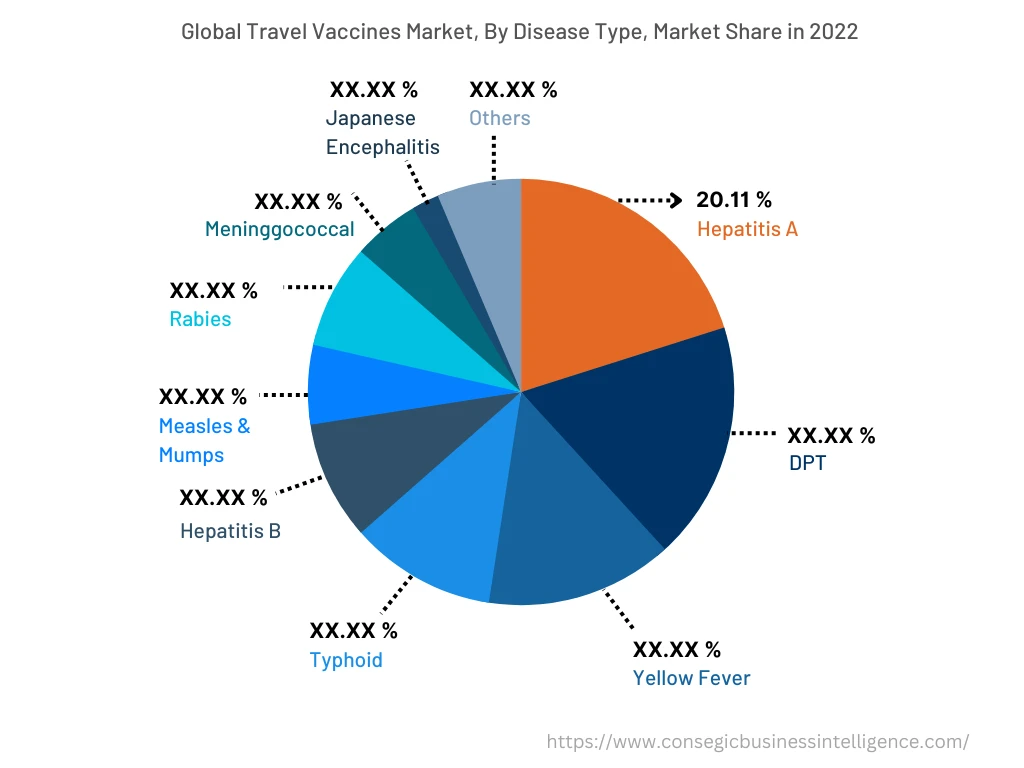
By Traveler Type :
The traveler type segment is categorized into inbound and outbound. In 2022, the inbound segment accounted for the highest market share in the travel vaccines market. Inbound travelers are individuals who are visiting a particular country or region from another country. Inbound travelers include tourists, business travelers, students, and immigrants. These travelers need to comply with the health regulations and requirements of the destination country, which include mandatory vaccinations or proof of immunization. Hence, the need to protect travelers against diseases prevalent in the destination country and to meet the entry requirements in a particular region is driving the demand for travel vaccines market trends.
However, the outbound segment is expected to grow at the fastest CAGR in the travel vaccines market during the forecast period. Outbound travelers are individuals traveling from their home country to another country or region. Outbound traveling includes vacations, exploring new destinations, attending conferences or meetings, or engaging in international trade. Further, outbound travelers require vaccines to protect themselves from diseases that are prevalent in the destination country.
For instance, according to the U.S. Department of Commerce, National Travel and Tourism Office from the Bureau of Economic Analysis, in 2021, outbound travelers from the U.S. spent more than USD 8 billion, with an increase of 67.6 % from the previous year. Hence, the increasing expenditure by outbound travelers is a key factor anticipated to drive market growth and trends.
By Region :
The regional segment includes North America, Europe, Asia Pacific, the Middle East and Africa, and Latin America.
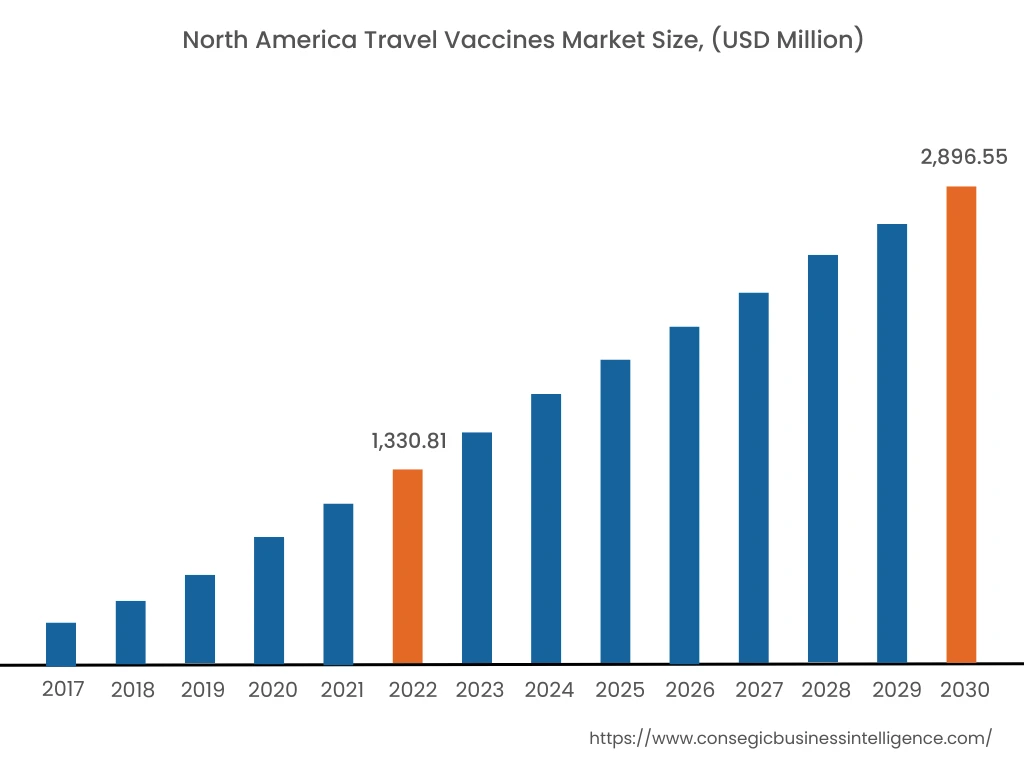
In 2022, North America accounted for the highest market share at 40.45% and was valued at USD 1,330.81 million, and is expected to reach USD 2,896.55 million in 2030. In North America, the U.S. accounted for the highest market share of 68.40% during the base year of 2022 owing to the high healthcare expenditure, advanced healthcare infrastructure, and extensive international travel.
Based on the travel vaccines market analysis, the region is a major hub for both business and leisure travel, leading to a higher demand for these vaccines. For instance, according to the Tourism Economics and U.S. Travel Association, in 2021, the total travel spending of domestic leisure travelers in the U.S. amounted to USD 751 billion and the international travel spending in the U.S. amounted to USD 40 million. Hence, the increasing travel spending in the U.S. is driving the growth and trends of the market in the region.
However, Asia Pacific is expected to grow at the fastest CAGR of 11.8% over the forecast period owing to the increasing number of outbound travel from countries such as China and India. Additionally, the growing awareness of travel health and the availability of affordable vaccines is anticipated to contribute to the growth of the region.
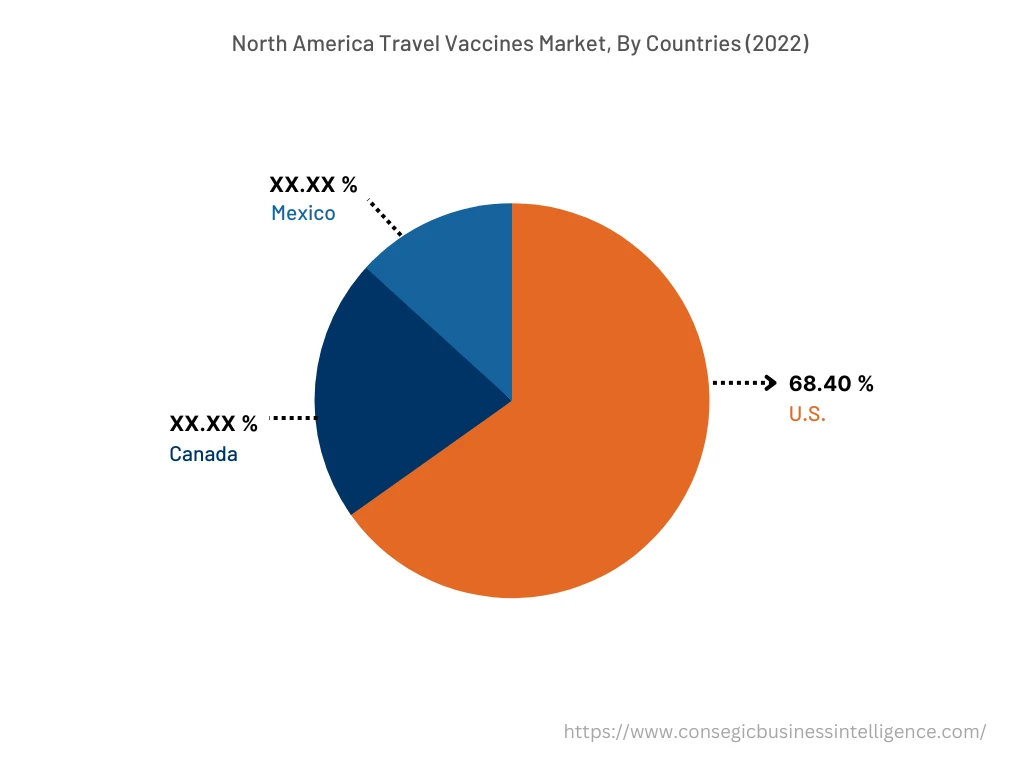
Top Key Players & Market Share Insights:
The global travel vaccines market is highly competitive, with several large players and numerous small and medium-sized enterprises. These companies have strong research and development capabilities and a strong presence in the market through their extensive product portfolios and distribution networks. The market is characterized by intense competition, with companies focusing on expanding their product offerings and increasing their market share through mergers, acquisitions, and partnerships. The key players in the travel vaccines industry include-
- Merck & Co., Inc.
- Pfizer Inc.
- Bavarian Nordic
- Emergent
- Seqirus
Recent Industry Developments :
- In June 2022, Pfizer Inc. announced the acquisition of ReViral, a privately held, clinical-stage biopharmaceutical company to develop, discover, and commercialize novel antiviral therapeutics and vaccines to target respiratory syncytial virus (RSV).
- In January 2022, Pfizer and BioNTech sign a new global collaboration agreement to develop the first mRNA-based shingles vaccine with the aim to accelerate the development of an improved vaccine for shingles, a painful disease that affects people all over the world.
Key Questions Answered in the Report
What was the market size of the travel vaccines industry in 2022? +
In 2022, the market size of travel vaccines was USD 3,290.00 million
What will be the potential market valuation for the travel vaccines industry by 2030? +
In 2030, the market size of travel vaccines will be expected to reach USD 7,137.89 million.
What are the key factors driving the growth of the travel vaccines market? +
Governmental policies and regulations to promote the adoption of travel vaccines and the growing tourism industry are the key factors driving the growth of the travel vaccines market.
What is the dominating segment in the travel vaccines market, by composition? +
In 2022, the mono vaccines segment accounted for the highest market share in the overall travel vaccines market.
Based on current market trends and future predictions, which geographical region will have the fastest impact on the travel vaccines market's growth in the coming years? +
Asia Pacific is expected to be the fastest-growing region in the market during the forecast period.
